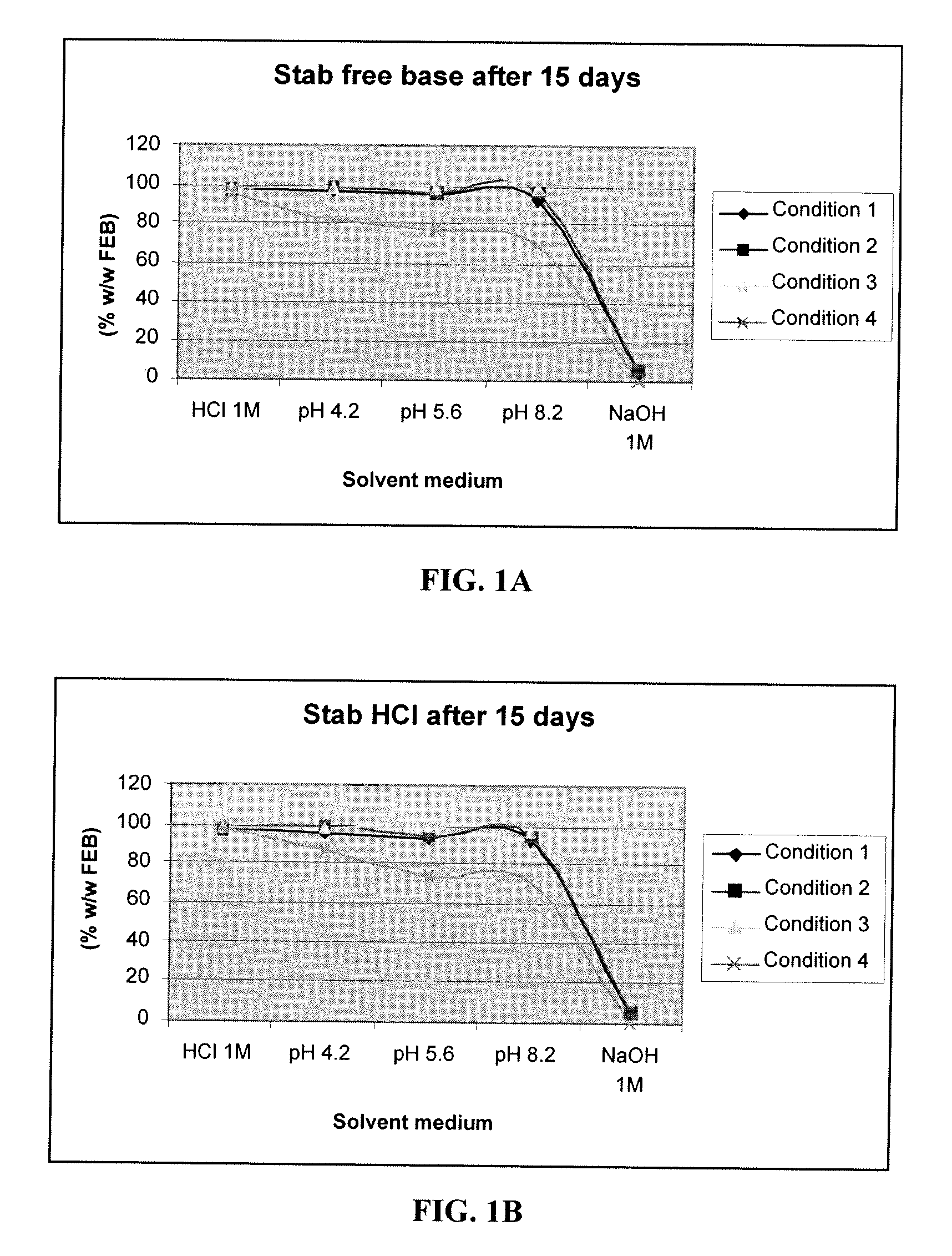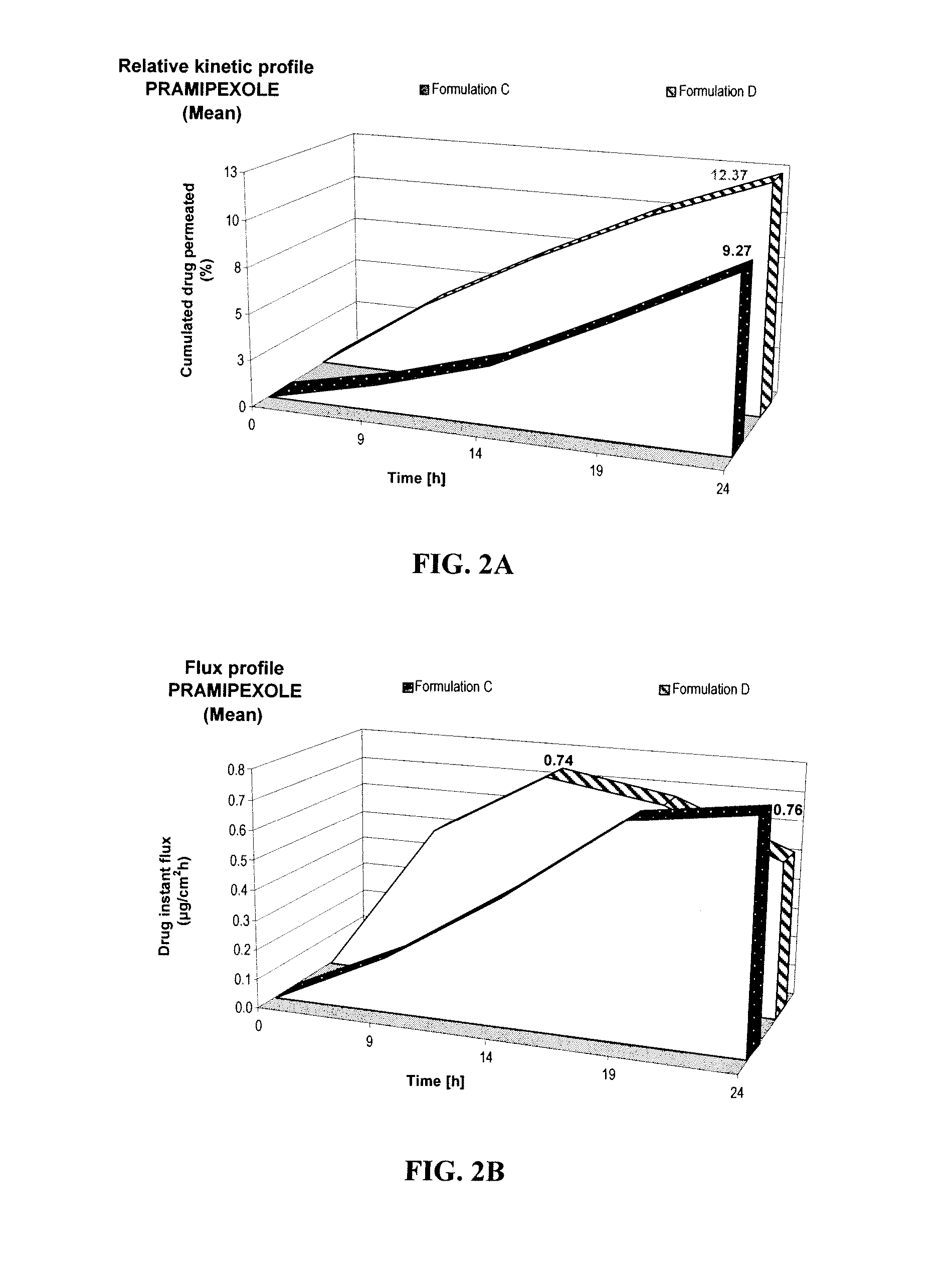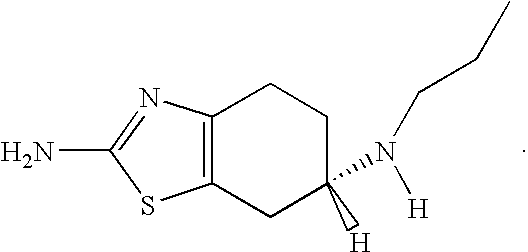Transdermal composition having enhanced color stability
- Summary
- Abstract
- Description
- Claims
- Application Information
AI Technical Summary
Benefits of technology
Problems solved by technology
Method used
Image
Examples
example 1
Effect of pH on degradation of dopamine agonist
[0044] Degradation of a commonly-used dopamine agonist, in free base and hydrochloride forms, at various pH was evaluated under the following four conditions. The results are shown in Tables 1 and 2.
[0045] Condition 1: ambient temperature, at dark
[0046] Condition 2: ambient temperature, exposed at day light
[0047] Condition 3: 5° C. (at dark)
[0048] Condition 4: 60° C. (at dark)
TABLE 1Stability of a dopamine agonist in free base form as a function of pHHCl 1MpH 4.2pH 5.6pH 8.2NaOH 1MT096.7498.5298.2997.7892.99After 15Condition 197.6596.5195.5092.464.10daysCondition 297.4898.4596.3196.544.90Condition 398.1398.5798.8397.9722.48Condition 496.4382.1577.4469.070.00
[0049]
TABLE 2Stability of a dopamine agonist in hydrochloride form as a function of pHHCl 1MpH 4.2pH 5.6pH 8.2NaOH 1MT097.6598.4698.5197.6993.58After 15Condition 197.8495.6393.4692.414.58daysCondition 298.2799.4994.4994.734.94Condition 397.8797.8199.5597.2527.18Condition 497.5...
example 2
Screening of Antioxidants
[0052] The LC-MS structure elucidation analysis has demonstrated that coloration of an anti-Parkinson dopamine agonist, e.g., pramipexole, is linked to the degradation of the drug. Thus, coloration can be used as surrogate to assess stability of formulations containing such anti-Parkinson agents. A preliminary study was performed to evaluate the effects of various antioxidants and chelating agents on coloration of formulations containing a dopamine agonist.
[0053] The following materials were screened:
[0054] Edetic acid (EDTA)
[0055] Butylhydroxytoluene (BHT)
[0056] Propyl gallate (ProGL)
[0057] Sodium metabisulfite (Na2MET)
Edetic acid and edetates are chelating agents commonly considered as antioxidant synergists. BHT, ProGL and Na2MET are considered as true antioxidants.
[0058] The testing levels were selected based on the concentrations normally used in pharmaceutical applications (see HANDBOOK OF PHARMACEUTICAL EXCIPIENTS, 4th ed. (Pharmaceutical Pre...
example 3
The effect of sodium metabisulfite on pramipexole stability
[0062] It is well known that pramipexole dihydrochloride salt is unstable in commonly used pharmaceutical solvents and exhibits rapid, massive discoloration ranging from light to dark yellow. Pramipexole dihydrochloride salt becomes yellowish in semi-solid and liquid formulations upon accelerated aging. The following experiment was performed to assess the effects of antioxidants and chelating agents on coloration of pramipexole hydrochloride formulations.
[0063] Various formulations containing 2.00% wt pramipexole hydrochloride (expressed as free base equivalent) were prepared, each containing one of the following agents: edetic sodium salts, butylhydroxytoluene, butylhydroxyanisole, propyl gallate, ascorbyl palmitate, ascorbic acid, tocopherol, and sulfites. The concentration of each agent was as recommended in the HANDBOOK OF PHARMACEUTICAL EXCIPIENTS (4th ed.). A formulation free of antioxidants served as a blank referen...
PUM
| Property | Measurement | Unit |
|---|---|---|
| Temperature | aaaaa | aaaaa |
| Temperature | aaaaa | aaaaa |
| Time | aaaaa | aaaaa |
Abstract
Description
Claims
Application Information
 Login to View More
Login to View More - R&D
- Intellectual Property
- Life Sciences
- Materials
- Tech Scout
- Unparalleled Data Quality
- Higher Quality Content
- 60% Fewer Hallucinations
Browse by: Latest US Patents, China's latest patents, Technical Efficacy Thesaurus, Application Domain, Technology Topic, Popular Technical Reports.
© 2025 PatSnap. All rights reserved.Legal|Privacy policy|Modern Slavery Act Transparency Statement|Sitemap|About US| Contact US: help@patsnap.com



